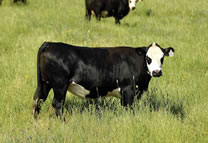Australian cattlemen have a history of embracing new technologies and responding to the demands of the market. Modern breeding techniques are a vital part of the beef industry, allowing seedstock producers to maximise the expression of the high quality genetics at their disposal.
Performance recording of beef cattle in Australia has been coordinated by the National Beef Recording Scheme (NBRS) since its formation in 1972. The NBRS developed and introduced BREEDPLAN in 1985.
BREEDPLAN is a modern genetic evaluation system for beef cattle breeders, based at the University of New England at Armidale in New South Wales.
BREEDPLAN offers bull breeders the potential to accelerate genetic progress in their herds. It also provides objective information on cattle sold to commercial breeders.
Breeding Values (EBVs) for a range of traits. The EBV is based on the animal’s own performance, the performance of known relatives, and the heritability of each trait and the relationship between the different traits. In other words, BREEDPLAN combines all traits in one analysis.
All breeds of beef cattle in Australia use BREEDPLAN and, for most breeds, the BREEDPLAN genetic evaluation system has been integrated with the respective association’s pedigree system. This has demonstrated substantial genetic improvement for commercially important traits.
The Animal Genetics and Breeding Unit (AGBU) at the University of New England (UNE) undertake research into the genetic evaluation system on behalf of BREEDPLAN. In addition, the Beef Quality Cooperative Research Centre, also at UNE, undertakes detailed research and field trials to determine the relationship between genetics and beef quality. This information is used by AGBU to update the BREEDPLAN system.
BREEDPLAN technology is highly regarded overseas and in some countries it is available under licence. It has been adopted as the national beef recording scheme in Australia, New Zealand, the US, Argentina, the UK and Mexico.
Genetic databases for particular breeds in these countries are now being merged to conduct international genetics evaluations. This is because the larger the population of cattle being evaluated, the higher the chance of finding elite genetic material. This can then be rapidly disseminated using artificial breeding techniques to improve competitiveness and beef production in all cooperating countries.
.
